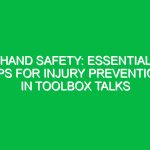Introduction
In the construction industry, safety is not just an option; it is a necessity. Toolbox talks in construction serve as a critical component of the health, safety, and Environment (HSE) domain. These brief, informal meetings focus on specific Safety issues relevant to the job site, providing workers with essential information to minimize risks and enhance Safety practices. By fostering a culture of safety through these discussions, construction teams can significantly reduce accidents and injuries, ensuring that everyone returns home safely at the end of the day.
Toolbox talks construction are designed to be inclusive, engaging, and practical. They can cover a wide range of topics, from equipment handling to environmental safeguarding. In this article, we will explore the key aspects of Toolbox Talks, their importance in promoting safety culture, and the Best Practices that can lead to successful implementation within the HSE framework.
Understanding Toolbox Talks in Construction
Toolbox talks construction are short, focused discussions that typically occur before the start of a work shift or at the beginning of a particular task. These talks are generally led by a supervisor or safety officer and involve all personnel on-site. Their primary objective is to remind workers of safety protocols, discuss potential Hazards, and encourage communication about safety issues.
Key Components of Effective Toolbox Talks
To be effective, toolbox talks should encompass several key components:
- Relevance: The topic should be directly related to the specific tasks being performed or the conditions present on the job site.
- Clarity: Clear communication is essential. Use straightforward language and avoid technical jargon that might confuse workers.
- Engagement: Encourage participation from everyone present. This can be achieved through open discussions, questions, and sharing personal experiences.
- Documentation: Keep records of each Toolbox Talk. This documentation not only serves as a reminder of topics covered but also demonstrates compliance with safety Regulations.
Benefits of Toolbox Talks
Implementing toolbox talks construction can yield numerous Benefits, including:
- Increased Safety Awareness: Regular discussions about safety keep Hazards at the forefront of workers’ minds.
- Enhanced Communication: Toolbox talks encourage dialogue between workers and supervisors, fostering an environment where safety concerns can be addressed promptly.
- Reduced Accidents: By continuously reinforcing safety protocols, toolbox talks can lead to a decrease in workplace accidents and injuries.
- Improved Team Cohesion: Engaging in these discussions helps build a sense of community among workers, promoting teamwork and mutual support.
Key Topics for Toolbox Talks in Construction
When planning toolbox talks, it is crucial to address relevant topics that resonate with the workforce. Below are some essential subjects to consider:
1. Personal Protective Equipment (PPE)
Discussing the proper use of PPE is fundamental. Workers should understand the importance of wearing helmets, gloves, eye protection, and other gear designed to safeguard against workplace hazards. Sharing real-life incidents where PPE usage prevented injuries can reinforce its significance.
2. Fall Protection
Falls are one of the leading causes of injuries in construction. Toolbox talks should cover the correct use of Fall Protection systems, including harnesses, guardrails, and safety nets. Engaging workers in discussions about their experiences with Fall Hazards can provide valuable insights and reinforce safety protocols.
3. Hazardous Materials
Construction sites often involve the use of hazardous substances. Toolbox talks should address the safe handling, storage, and disposal of such materials. Discussing the Material Safety Data Sheets (MSDS) and the importance of understanding chemical hazards can enhance workers’ awareness.
4. Equipment Safety
Workers must be trained on the safe Operation of machinery and tools. Discussing specific equipment, such as cranes, forklifts, and power tools, can help identify common hazards and proper operating Procedures. Real-life case studies of equipment-related accidents can serve as powerful reminders of the need for vigilance.
5. Emergency Procedures
Every construction site should have clear emergency procedures in place. Toolbox talks should cover evacuation routes, first aid measures, and the location of emergency equipment. Engaging workers in role-playing scenarios can help solidify their understanding of these procedures.
6. Environmental Considerations
With an increasing focus on Sustainability, toolbox talks should address environmental protection measures. Discussing waste management, pollution Prevention, and the responsible use of materials can promote environmental stewardship among workers.
Best Practices for Conducting Toolbox Talks
To maximize the effectiveness of toolbox talks construction, consider the following Best Practices:
1. Schedule Regular Talks
Consistency is key. Schedule toolbox talks at regular intervals, such as weekly or bi-weekly, to maintain a continuous focus on safety.
2. Tailor Topics to the Workforce
Understand the specific needs and challenges faced by your workforce. Tailoring topics to the unique aspects of your site and workers’ experiences can lead to more relevant and impactful discussions.
3. Use Visual Aids
Incorporate visual aids such as charts, videos, and handouts to enhance understanding. Visuals can help convey complex information in a digestible format.
4. Foster Open Communication
Encourage workers to voice their safety concerns and share experiences during toolbox talks. Creating an open environment can lead to valuable discussions and insights.
5. Lead by Example
Supervisors and safety officers should model safe behaviors and demonstrate a commitment to safety. This sets a positive example for workers and reinforces the importance of safety practices.
Regulations and Standards Impacting Toolbox Talks
Toolbox talks construction are influenced by various regulations and standards aimed at ensuring Workplace Safety. In many jurisdictions, regulations mandate regular safety Training and communication. For example, the Occupational Safety and Health Administration (OSHA) in the United States emphasizes the necessity of continuous education in safety practices.
Compliance with standards such as ISO 45001 for Occupational Health and safety management systems can also guide the development and implementation of toolbox talks. Understanding these regulations can help organizations structure their talks to meet legal requirements and ensure a safer work environment.
Conclusion
In conclusion, toolbox talks construction play an essential role in fostering a culture of safety within the construction industry. By addressing relevant topics, engaging workers, and promoting open communication, these discussions can significantly reduce accidents and injuries on job sites. Moreover, adhering to regulations and best practices ensures that toolbox talks remain effective and impactful.
As we move forward in the construction industry, it is crucial to prioritize health, safety, and environmental sustainability. By making toolbox talks a regular part of our safety protocols, we not only protect our workers but also contribute to a safer and more responsible industry as a whole. Let us encourage every team member to take ownership of safety, ensuring that everyone goes home safe at the end of the day.


